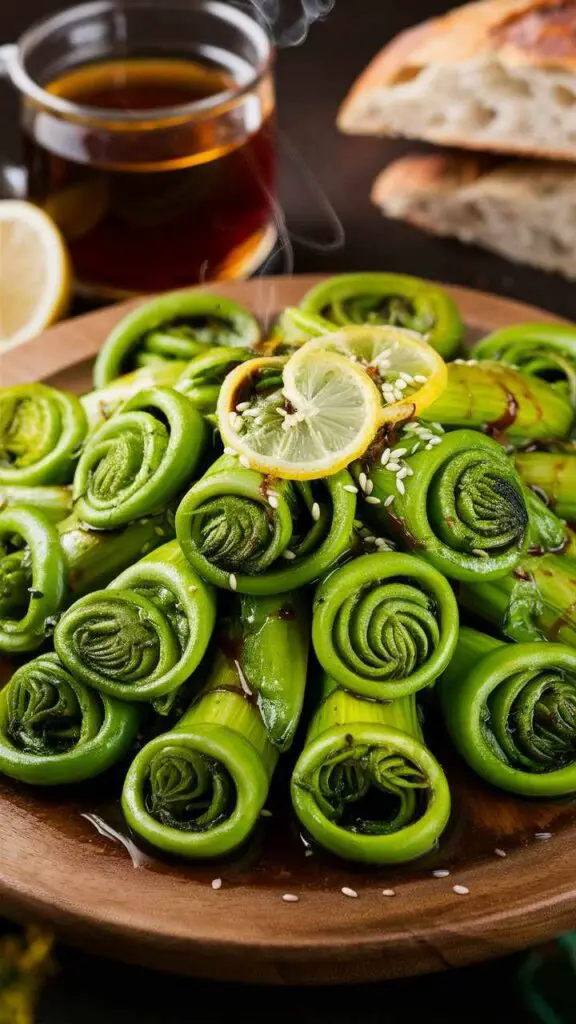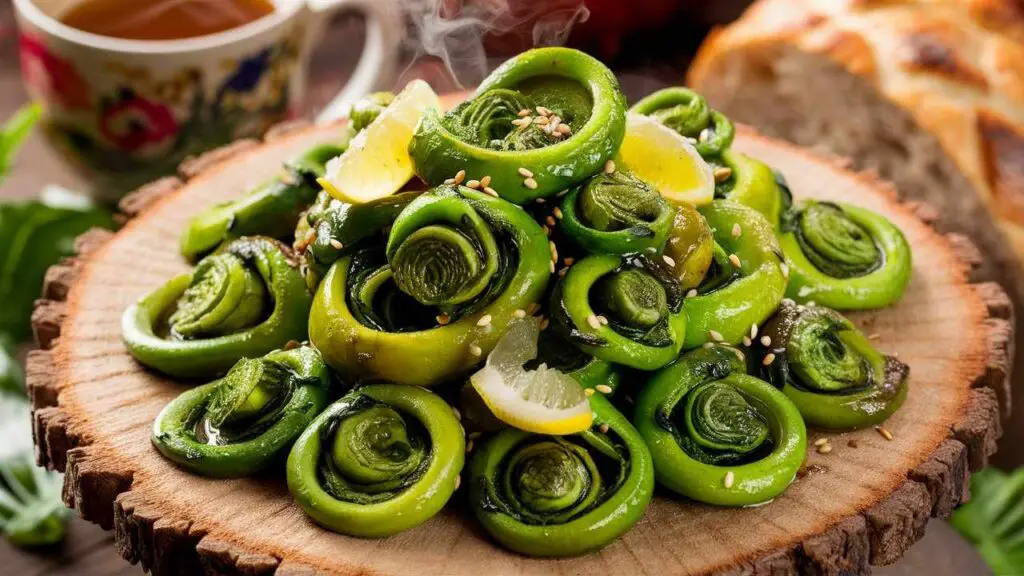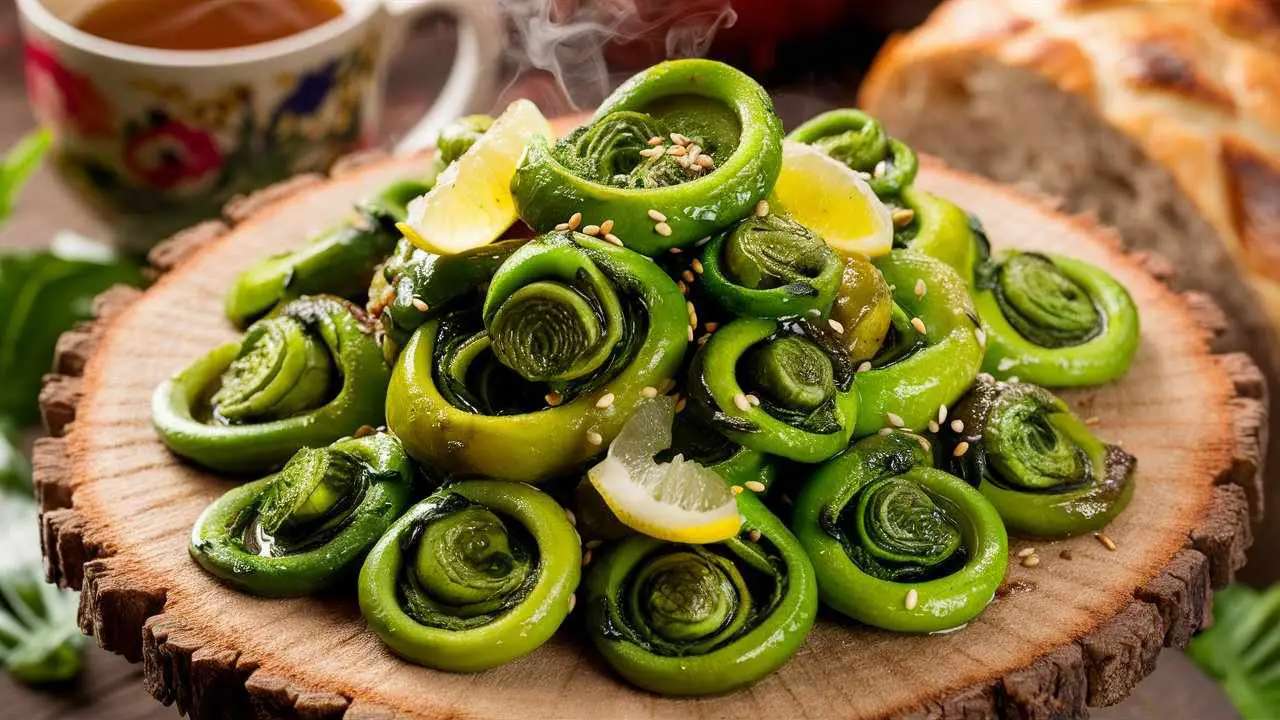If you stumble upon these tightly coiled, vibrant green spirals at your local farmers’ market or grocery store, consider yourself fortunate. Fiddlehead ferns, the edible shoots of the ostrich fern plant, are a fleeting springtime delicacy that have captured the hearts and palates of culinary enthusiasts worldwide. With their distinct, earthy flavor reminiscent of asparagus and green beans, these delicate morsels offer a unique culinary experience that celebrates the bounty of nature’s ephemeral offerings.

Ingredients (Quantity for 4 Servings)
To create a mouthwatering fiddlehead dish, you’ll need the following ingredients:
- 1 pound (450g) fresh fiddlehead ferns
- 2 tablespoons (30ml) olive oil or unsalted butter
- 3 cloves garlic, minced
- 1 teaspoon (5g) freshly grated ginger
- 1/4 teaspoon (1.25g) red pepper flakes (optional, for a hint of heat)
- 2 tablespoons (30ml) finely chopped shallots or scallions
- 1/2 teaspoon (2.5g) sea salt
- 1/4 teaspoon (1.25g) freshly ground black pepper
- Lemon wedges or a squeeze of fresh lemon juice (for serving)
Timing
- Preparation Time: 15 minutes
- Cooking Time: 20 minutes
- Total Time: 35 minutes
Step-by-Step Guide: How to Cook Fiddleheads
Step 1- Cleaning and Trimming: Start by thoroughly washing the fiddleheads under cool running water, gently rubbing off any dirt or debris that may be clinging to their coiled fronds. Trim off the dry, brown ends and discard any discolored or wilted fiddleheads.
Step 2- Blanching: Bring a large pot of salted water to a rolling boil. Once boiling, carefully add the cleaned fiddleheads and blanch them for 10 minutes. This crucial step not only eliminates any potential bacteria or toxins but also helps to soften the fiddleheads and enhance their flavor.
Step 3- Shocking and Drying: After blanching, immediately transfer the fiddleheads to an ice bath or rinse them under cold running water to halt the cooking process and preserve their vibrant green hue. Drain them well and pat them dry with a clean kitchen towel or paper towels.
Step 4- Sautéing: In a large skillet or sauté pan, heat the olive oil or butter over medium-high heat. Add the minced garlic, grated ginger, red pepper flakes (if using), and chopped shallots or scallions. Sauté for 1-2 minutes, or until fragrant, being careful not to burn the garlic.
Step 5- Cooking the Fiddleheads: Increase the heat to high and add the blanched and dried fiddleheads to the skillet. Toss or stir-fry them for 5-7 minutes, or until they develop a few golden-brown spots and are heated through. Season with salt and pepper to taste.
Step 6- Serving: Remove the sautéed fiddleheads from the heat and transfer them to a serving dish. Squeeze fresh lemon juice over the top or serve with lemon wedges on the side for a bright, citrusy note that perfectly complements the earthy flavors of the fiddleheads.

Essential Tips for Preparing Fiddleheads Safely
While fiddleheads are a delectable treat, it’s crucial to handle and prepare them with care to ensure their safe consumption. Here are some essential tips to keep in mind:
Proper Identification: Always ensure that you’re working with the edible ostrich fern variety (Matteuccia struthiopteris). Other fern species can be toxic and should be avoided.
Thorough Cleaning: Fiddleheads grow in moist, wooded areas and can harbor dirt, debris, and potential contaminants. Thoroughly washing and rinsing them multiple times is essential to remove any lingering particles.
Adequate Cooking: Never consume fiddleheads raw or undercooked. Proper cooking, either by blanching or thoroughly sautéing, is crucial to eliminate any potential toxins or bacteria that may be present.
Freshness Matters: Choose fiddleheads that are fresh, bright green, and tightly coiled. Avoid any that appear wilted, discolored, or have an off-putting odor, as these signs indicate spoilage.
By following these guidelines, you can enjoy the flavors of fiddleheads while prioritizing your safety and well-being.
How to Incorporate Fiddleheads into Everyday Dishes
Fiddleheads are incredibly versatile and can be seamlessly incorporated into a variety of dishes, adding a unique twist to your culinary repertoire. Here are some creative ways to incorporate these verdant gems into your everyday meals:
Salads: Toss blanched or sautéed fiddleheads into fresh green salads for a burst of texture and flavor. They pair beautifully with ingredients like cherry tomatoes, crumbled feta, and a zingy vinaigrette.
Pasta Dishes: Sauté fiddleheads with garlic, olive oil, and your favorite herbs, then toss them with cooked pasta for a delightful primavera-style dish.
Stir-Fries: Fiddleheads make an excellent addition to stir-fries, complementing other seasonal vegetables and proteins like chicken, shrimp, or tofu.
Frittatas and Quiches: Incorporate sautéed fiddleheads into your favorite egg dishes for a unique twist on breakfast or brunch.
Risotto: Stir blanched fiddleheads into creamy risotto for a delightful contrast of textures and flavors.
Soups and Stews: Add fiddleheads to vegetable soups or hearty stews for a burst of springtime freshness.
With a little creativity, fiddleheads can elevate your everyday meals, adding a touch of whimsy and seasonality to your culinary adventures.
Best Seasonings and Pairings for Fiddlehead Recipes
While fiddleheads boast a distinct and delightful flavor on their own, their earthy notes can be beautifully complemented by a variety of seasonings and pairings. Here are some of my favorite combinations:
Garlic and Ginger: The warm, aromatic notes of garlic and ginger perfectly accentuate the earthiness of fiddleheads, creating a harmonious blend of flavors.
Lemon or Lime: A bright squeeze of citrus, such as lemon or lime juice, adds a refreshing zing that cuts through the richness of the fiddleheads and enhances their natural flavors.
Herbs: Fresh herbs like parsley, chives, dill, or tarragon can add a vibrant, herbaceous note to fiddlehead dishes.
Mushrooms: The umami-rich flavors of mushrooms, such as shiitake or oyster mushrooms, pair beautifully with the earthy undertones of fiddleheads.
Bacon or Pancetta: The smoky, salty flavors of bacon or pancetta provide a delightful contrast to the delicate fiddleheads.
Cheese: Creamy cheeses like feta, goat cheese, or Parmesan can add a tangy richness to fiddlehead dishes.
Experiment with these flavor combinations to create dishes that showcase the unique character of fiddleheads while complementing their inherent flavors.
Nutritional Facts (per 100g serving)
Fiddleheads are not only a culinary delight but also a nutritional powerhouse. Here are the nutritional facts for a 100g serving:
- Calories: 86
- Total Fat: 3g
- Saturated Fat: 2g
- Carbohydrates: 16g
- Dietary Fiber: 5g
- Protein: 1g
- Vitamin C: 36mg (179% of the Daily Value)
- Iron: 0.3mg (3% of the Daily Value)
- Potassium: 78mg (2% of the Daily Value)
Fiddleheads are an excellent source of vitamin C, providing nearly twice the recommended daily intake in a single serving. They also offer a good amount of dietary fiber, contributing to a healthy digestive system. Additionally, fiddleheads are low in calories and fat, making them a guilt-free indulgence for those watching their intake.
Conclusion
Cooking with fiddleheads is an art that celebrates the fleeting beauty of nature’s ephemeral offerings. These delicate, coiled shoots not only delight the palate with their unique flavor but also provide a nutritious and sustainable culinary experience. By following the tips and techniques outlined in this guide, you can confidently navigate the world of fiddlehead cooking, ensuring both safety and flavor in every bite.
Embrace the fleeting magic of fiddlehead season and incorporate these verdant treasures into your culinary adventures. Whether sautéed with aromatic garlic and ginger, tossed into vibrant salads, or incorporated into hearty risottos, fiddleheads will undoubtedly add a touch of whimsy and seasonality to your dishes.
So, the next time you encounter these elusive delights, seize the opportunity and let their earthy essence transport you to the lush, verdant landscapes from whence they came. Happy cooking, and may your fiddlehead endeavors be as delightful as the first blush of spring itself!
FAQs
Can fiddleheads be eaten raw?
No, fiddleheads should never be consumed raw. They contain natural toxins that can cause digestive issues if not properly cooked. Always blanch or thoroughly sauté fiddleheads before eating.
How long do fiddleheads stay fresh?
Fiddleheads have a very short shelf life, typically lasting only a few days when stored properly in the refrigerator. It’s best to consume them as soon as possible after purchase or foraging.
Can I freeze fiddleheads?
Yes, you can freeze fiddleheads for later use. Blanch them first, then spread them on a baking sheet and freeze them individually. Once frozen, transfer them to an airtight container or freezer bag, and they can be stored for up to a year.
Are all fern varieties edible?
No, not all fern varieties are edible. Only the ostrich fern (Matteuccia struthiopteris) is considered safe for consumption. It’s crucial to properly identify fiddleheads before harvesting or purchasing them.
Can fiddleheads be grown at home?
Yes, it’s possible to grow ostrich ferns and harvest their fiddleheads at home. However, it requires specific growing conditions, including moist, well-drained soil and partial shade. It may take several years for the ferns to establish and produce harvestable fiddleheads.
Are fiddleheads suitable for vegetarians and vegans?
Yes, fiddleheads are suitable for vegetarians and vegans, as they are a plant-based food source. However, it’s essential to ensure they are properly cleaned and cooked to eliminate any potential contaminants or toxins.
